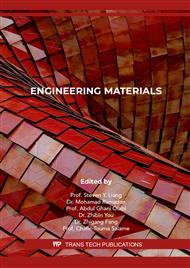[1]
J. Huang, H.O.T. Ware, R. Hai, G. Shao, C. Sun, Conformal Geometry and Multimaterial Additive Manufacturing through Freeform Transformation of Building Layers, Advanced Materials, 33 (2021) 2005672.
DOI: 10.1002/adma.202005672
Google Scholar
[2]
T.D. Ngo, A. Kashani, G. Imbalzano, K.T. Nguyen, D. Hui, Additive manufacturing (3D printing): A review of materials, methods, applications and challenges, Composites Part B: Engineering, 143 (2018) 172-196.
DOI: 10.1016/j.compositesb.2018.02.012
Google Scholar
[3]
J. Huang, Q. Qin, J. Wang, A review of stereolithography: Processes and systems, Processes, 8 (2020) 1138.
Google Scholar
[4]
Q. Qin, J. Huang, J. Yao, A real-time adaptive look-ahead speed control algorithm for FDM-based additive manufacturing technology with Hbot kinematic system, Rapid Prototyping Journal, DOI (2019).
DOI: 10.1108/rpj-11-2018-0291
Google Scholar
[5]
Y. Wu, H. Hou, S. Liu, Q. Wen, A Review of FDM Nozzle System for Additional Materials Manufacturing Technology, Springer Singapore, Singapore, 2020, pp.517-522.
Google Scholar
[6]
B.N. Turner, R. Strong, S.A. Gold, A review of melt extrusion additive manufacturing processes: I. Process design and modeling, Rapid Prototyping Journal, DOI (2014).
DOI: 10.1108/rpj-01-2013-0012
Google Scholar
[7]
F. Peng, B.D. Vogt, M. Cakmak, Complex flow and temperature history during melt extrusion in material extrusion additive manufacturing, Additive Manufacturing, 22 (2018) 197-206.
DOI: 10.1016/j.addma.2018.05.015
Google Scholar
[8]
H. Jeon, J. Park, S. Kim, K. Park, C. Yoon, Effect of nozzle temperature on the emission rate of ultrafine particles during 3D printing, Indoor Air, 30 (2020) 306-314.
DOI: 10.1111/ina.12624
Google Scholar
[9]
S. Ding, B. Zou, P. Wang, H. Ding, Effects of nozzle temperature and building orientation on mechanical properties and microstructure of PEEK and PEI printed by 3D-FDM, Polymer Testing, 78 (2019) 105948.
DOI: 10.1016/j.polymertesting.2019.105948
Google Scholar
[10]
N.A. Sukindar, M. Ariffin, B.H.T. Baharudin, C.N.A. Jaafar, M.I.S. Ismail, Analyzing the effect of nozzle diameter in fused deposition modeling for extruding polylactic acid using open source 3D printing, Jurnal Teknologi, 78 (2016).
DOI: 10.11113/jt.v78.6265
Google Scholar
[11]
K. Manikandan, X. Jiang, A.A. Singh, B. Li, H. Qin, Effects of Nozzle Geometries on 3D Printing of Clay Constructs: Quantifying Contour Deviation and Mechanical Properties, Procedia Manufacturing, 48 (2020) 678-683.
DOI: 10.1016/j.promfg.2020.05.160
Google Scholar
[12]
W. Lao, M. Li, T. Tjahjowidodo, Variable-geometry nozzle for surface quality enhancement in 3D concrete printing, Additive Manufacturing, 37 (2021) 101638.
DOI: 10.1016/j.addma.2020.101638
Google Scholar
[13]
V. Nienhaus, K. Smith, D. Spiehl, E. Dörsam, Investigations on nozzle geometry in fused filament fabrication, Additive Manufacturing, 28 (2019) 711-718.
DOI: 10.1016/j.addma.2019.06.019
Google Scholar
[14]
J.H. Park, M.-Y. Lyu, S.Y. Kwon, H.J. Roh, M.S. Koo, S.H. Cho, Temperature Analysis of Nozzle in a FDM Type 3D Printer Through Computer Simulation and Experiment, Elastomers and composites, 51 (2016) 301-307.
DOI: 10.7473/ec.2016.51.4.301
Google Scholar
[15]
B. Akhoundi, M. Nabipour, F. Hajami, D. Shakoori, An Experimental Study of Nozzle Temperature and Heat Treatment (Annealing) Effects on Mechanical Properties of High‐Temperature Polylactic Acid in Fused Deposition Modeling, Polymer Engineering & Science, 60 (2020) 979-987.
DOI: 10.1002/pen.25353
Google Scholar
[16]
T. Sonsalla, A.L. Moore, W. Meng, A.D. Radadia, L. Weiss, 3-D printer settings effects on the thermal conductivity of acrylonitrile butadiene styrene (ABS), Polymer Testing, 70 (2018) 389-395.
DOI: 10.1016/j.polymertesting.2018.07.018
Google Scholar
[17]
N. Sa'ude, M. Ibrahim, M.H.I. Ibrahim, Melt flow behavior of metal filled in polymer matrix for fused deposition modeling (FDM) filament, Applied Mechanics and Materials, Trans Tech Publ, 2014, pp.84-88.
DOI: 10.4028/www.scientific.net/amm.660.84
Google Scholar
[18]
D. Yang, H. Zhang, J. Wu, E.D. McCarthy, Fibre flow and void formation in 3D printing of short-fibre reinforced thermoplastic composites: An experimental benchmark exercise, Additive Manufacturing, 37 (2021) 101686.
DOI: 10.1016/j.addma.2020.101686
Google Scholar
[19]
V. Sharma, H. Roozbahani, M. Alizadeh, H. Handroos, 3D Printing of Plant-Derived Compounds and a Proposed Nozzle Design for the More Effective 3D FDM Printing, IEEE Access, 9 (2021) 57107-57119.
DOI: 10.1109/access.2021.3071459
Google Scholar
[20]
T.A. Osswald, J. Puentes, J. Kattinger, Fused filament fabrication melting model, Additive Manufacturing, 22 (2018) 51-59.
DOI: 10.1016/j.addma.2018.04.030
Google Scholar
[21]
K. Henke, D. Talke, C. Matthäus, Additive Manufacturing by Extrusion of Lightweight Concrete - Strand Geometry, Nozzle Design and Layer Layout, in: F.P. Bos, S.S. Lucas, R.J.M. Wolfs, T.A.M. Salet (Eds.) Second RILEM International Conference on Concrete and Digital Fabrication, Springer International Publishing, Cham, 2020, pp.906-915.
DOI: 10.1007/978-3-030-49916-7_88
Google Scholar
[22]
T. Stichel, T. Laumer, T. Baumüller, P. Amend, S. Roth, Powder layer preparation using vibration-controlled capillary steel nozzles for Additive Manufacturing, Physics Procedia, 56 (2014) 157-166.
DOI: 10.1016/j.phpro.2014.08.158
Google Scholar
[23]
D. Ravoori, H. Prajapati, V. Talluru, A. Adnan, A. Jain, Nozzle-integrated pre-deposition and post-deposition heating of previously deposited layers in polymer extrusion based additive manufacturing, Additive Manufacturing, 28 (2019) 719-726.
DOI: 10.1016/j.addma.2019.06.006
Google Scholar
[24]
D. Nuyttens, K. Baetens, M. De Schampheleire, B. Sonck, Effect of nozzle type, size and pressure on spray droplet characteristics, Biosystems engineering, 97 (2007) 333-345.
DOI: 10.1016/j.biosystemseng.2007.03.001
Google Scholar
[25]
J.Peng, J.Li, J.Chen, S.liu, Numerical study of the effect of flow rate and temperature on parison swell and sag in extrusion, Journal of Beijing Institute of Technology, 3 (2013).
Google Scholar
[26]
M. Yan, X. Tian, G. Peng, D. Li, X. Zhang, High temperature rheological behavior and sintering kinetics of CF/PEEK composites during selective laser sintering, Composites Science and Technology, 165 (2018) 140-147.
DOI: 10.1016/j.compscitech.2018.06.023
Google Scholar


